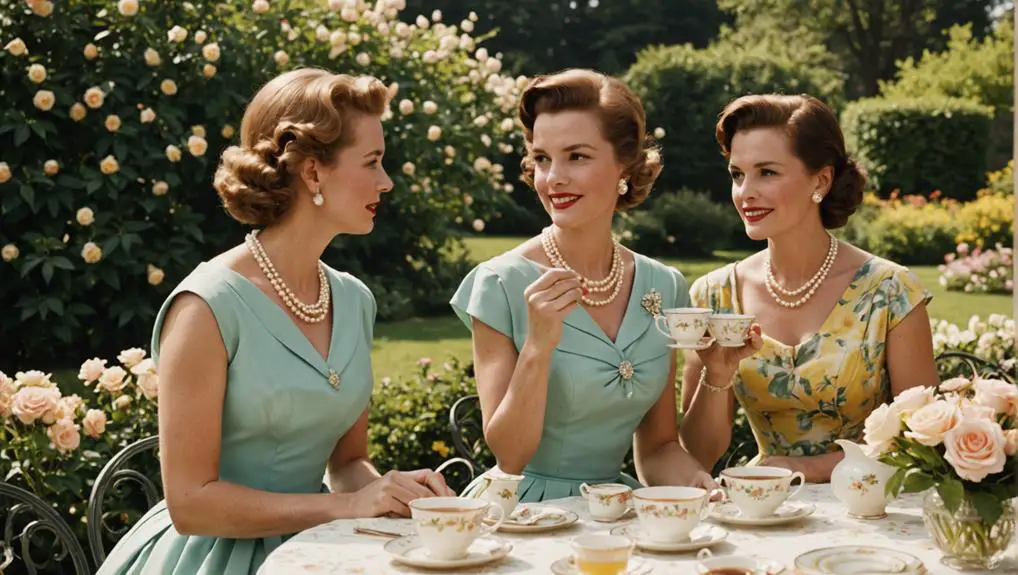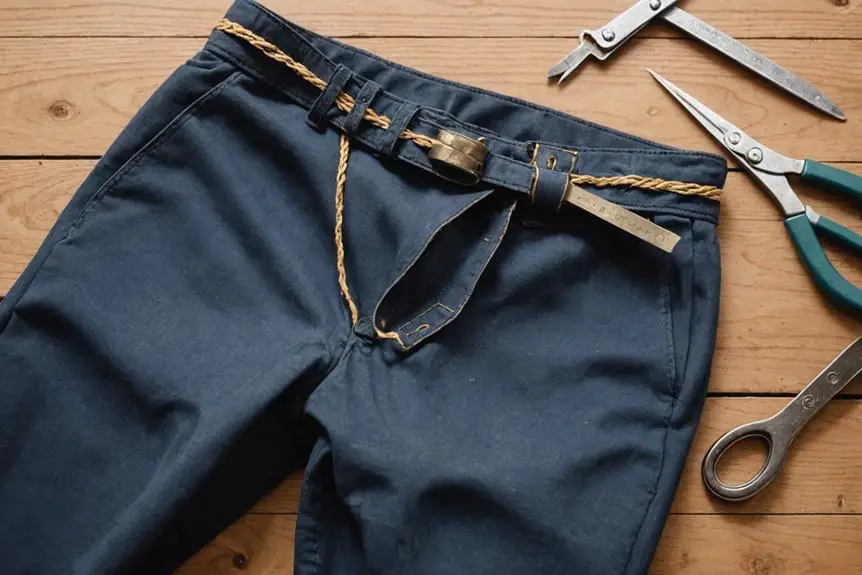In the 1950s, you'd find women's pearl necklaces as essential symbols of elegance and sophistication. Cultured pearls, particularly from Japan, gained immense popularity, reflecting a societal shift towards post-war refinement. Icons like Grace Kelly and Audrey Hepburn wore these vintage pieces, emphasizing their status and desirability. Characterized by their creamy white tones and meticulous craftsmanship, vintage pearls typically retailed around $1,693. These necklaces were versatile, often layered or mixed with other jewelry styles, allowing women to express individuality. Such trends defined the era, and discovering more about iconic designs and shopping tips will enhance your understanding of this timeless accessory.
Historical Context of the 1950s
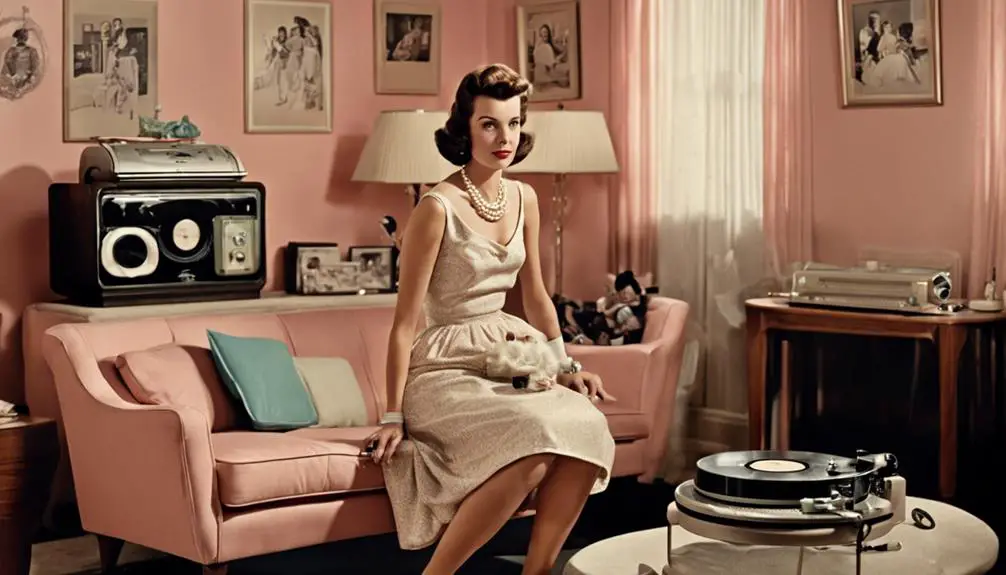
The 1950s ushered in a vibrant post-WWII economic boom, shaking off the shadows of conflict and setting the stage for a fashion renaissance. This was a decade where women's fashion flourished, reflecting a newfound prosperity and cultural optimism. Tailored dresses with cinched waists became the hallmark of feminine elegance, often paired with accessories that conveyed sophistication. Among these, the cultured pearl necklace emerged as a quintessential choice, symbolizing status and refinement.
Influential figures like Grace Kelly and Audrey Hepburn played pivotal roles in popularizing vintage pearl jewelry. Their iconic styles showcased how pearls could elevate any outfit, particularly the classic little black dress, which became a staple in women's wardrobes. This combination exuded a timeless chicness that defined an era.
Moreover, pearls transcended mere fashion; they represented a broader societal shift. As women embraced their roles in this new economic landscape, the elegance of pearls mirrored aspirations for wealth and social standing. The cultural significance of pearl jewelry during the 1950s consequently not only shaped personal style but also encapsulated the evolving identity of women in a post-war world.
The Rise of Pearl Necklaces
During the 1950s, pearl necklaces emerged as a defining accessory that complemented the era's fashion sensibilities. This period saw a remarkable surge in the popularity of classic pearl strands, particularly Akoya cultured pearls. Women embraced these elegant pieces, incorporating them into both formal and casual outfits, enhancing the tailored dresses and iconic little black dresses of the time.
Celebrities like Grace Kelly and Audrey Hepburn played pivotal roles in popularizing pearl necklaces, elevating them to symbols of sophistication and femininity. Their influence helped forge a strong cultural association between pearls and refined elegance, making them a must-have for women seeking to embody the era's style. The allure of these necklaces isn't just in their aesthetic; they also reflect a sense of timelessness and versatility.
As the decade progressed, the average price for vintage pearl necklaces reached around $1,693, indicating their enduring appeal and collectible nature. Even as fashion trends shifted in the 1960s towards colorful multistrand necklaces, the classic pearl necklace remained an essential staple. It's clear that the rise of pearl necklaces during the 1950s had a lasting impact on women's fashion.
Characteristics of Vintage Pearls
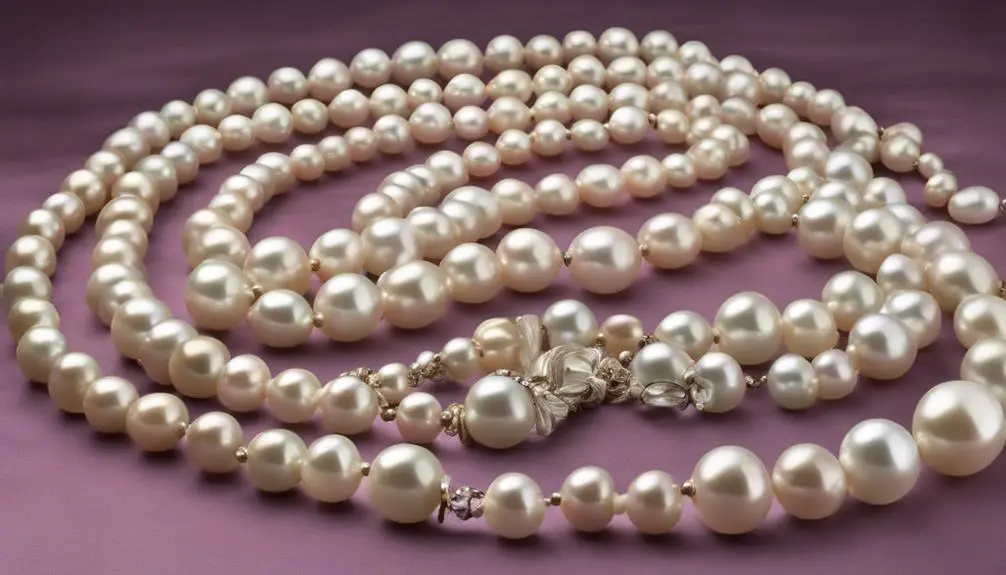
Vintage pearls from the 1950s stand out for their distinctive characteristics, making them sought-after treasures for collectors and fashion enthusiasts alike. The creamy white color and smooth, lustrous surface of cultured pearls define the era's vintage necklaces. Crafted with meticulous attention, these pieces often feature designs like the French 1950s cultured pearl choker, showcasing identical pearls and secure clasps.
Here's a closer look at their defining features:
| Characteristic | Description |
|---|---|
| Color | Creamy white, adding elegance |
| Surface | Smooth and lustrous, enhancing allure |
| Craftsmanship | Handcrafted designs, highlighting artistry |
| Materials | High-quality clasps, often gold or rose gold |
While the signs of wear, such as dull spots or blunted prongs, can indicate age and authenticity, these vintage necklaces maintain their charm and appeal. The average market price of around $1,693 reflects their desirability and investment potential. Collectors appreciate the quality and craftsmanship, ensuring that these vintage pearls remain timeless treasures in the world of fashion.
Iconic Designers of the Era
Iconic designers of the 1950s played a crucial role in shaping the landscape of women's fashion, particularly through their innovative use of pearl necklaces. Chanel, for instance, created the multistrand pearl necklace that elegantly combined pearls with emeralds and rubies, encapsulating the era's opulent aesthetic. This piece not only defined luxury but also became a highly collectible item, showcasing the designer's mastery of pearl jewelry.
Maison Gripoix followed suit, infusing their designs with unique motifs inspired by ancient civilizations. Their craftsmanship emphasized intricate settings and quality materials, often incorporating White Gold to enhance the allure of pearls. Meanwhile, Van Cleef & Arpels and David Webb contributed to the trend by blending artistic motifs with pearls, further elevating their status in women's fashion.
Mikimoto's influence can't be overlooked, as their cultured pearls made pearl necklaces a staple accessory for women. The craftsmanship during this period reflected a deep commitment to artistry and elegance, ensuring that pearl jewelry remained synonymous with sophistication. Together, these designers not only shaped the aesthetic of their time but also set enduring standards for the world of jewelry that continue to resonate today.
Mixing and Matching Styles
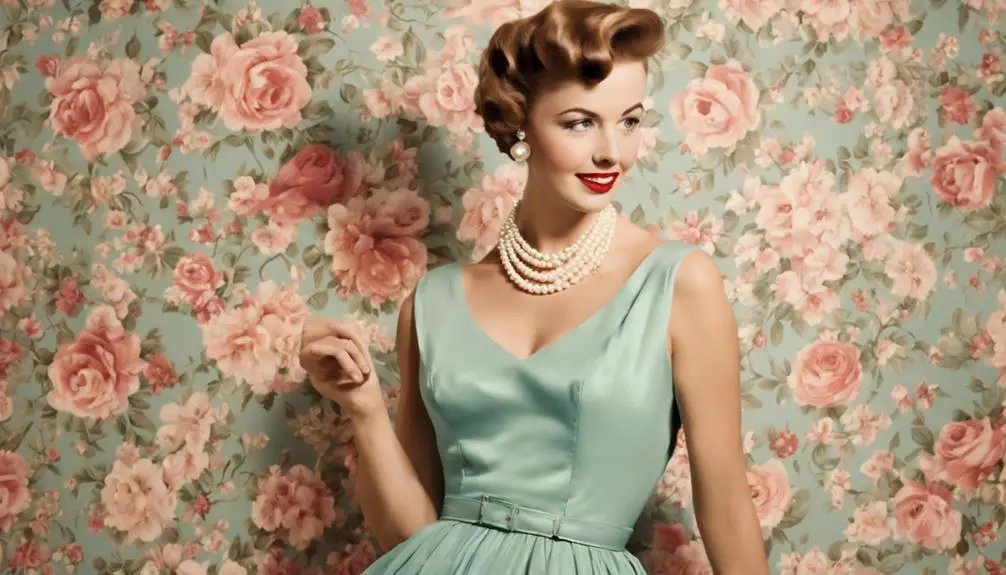
The 1950s marked a significant shift in how women approached accessorizing, particularly with pearl necklaces. You'll notice that this era celebrated the idea of mixing and matching styles, allowing you to create a unique, dynamic look with your jewelry. It became common to pair pearl necklaces with contrasting earrings, emphasizing personal style and individuality. Layering multiple strands of pearls became a popular trend, giving you the freedom to experiment with lengths and styles while enhancing the elegance of your outfit.
The versatility of pearls made them suitable for both formal events, like evening gowns, and casual outings, allowing for diverse combinations. You could easily pair a classic pearl necklace with a tailored dress featuring a cinched waist or the iconic little black dress, showcasing how pearls adapt beautifully to various fashion silhouettes.
Moreover, the 1950s also saw women combining jewelry pieces from different styles and eras, including gold accents, promoting personal expression. This approach to mixing and matching not only reflected the times but also encouraged you to embrace your individuality in accessorizing.
Featured Vintage Pearl Pieces
During the 1950s, pearl necklaces emerged as a quintessential accessory, showcasing not just timeless elegance but also a rich diversity in design. Vintage pieces from this era often feature cultured pearls, with the average price hovering around $1,693 on platforms like 1stDibs, underscoring their enduring value. A classic example includes the French 1950s cultured pearl choker, distinguished by its identical creamy white pearls and secure ratchet clasp, which not only guaranteed comfort but also complemented various outfits.
One of the most sought-after pieces is the Chanel multistrand necklace from the mid-1950s. This highly collectible item combines luxurious pearls with gemstones, creating a statement accessory that pairs beautifully with the iconic little black dress. Furthermore, the meticulous craftsmanship of many vintage pearl necklaces is evident in their use of quality materials like gold and rose gold, enhancing their visual appeal.
When you consider vintage pearl earrings alongside these necklaces, the 1950s emerge as a decade where sophistication and style effortlessly intertwine, making pearl jewelry an indispensable part of every woman's wardrobe.
Shopping for 1950s Necklaces

As interest in vintage pearl jewelry continues to grow, shopping for 1950s necklaces offers an exciting opportunity to own a piece of history. These necklaces, particularly those crafted from cultured pearls, are highly sought after, with average prices around $1,693 on platforms like 1stDibs. When you're on the hunt, focus on handcrafted designs and unique materials that distinguish these vintage pieces from modern styles.
Notable designers such as Chanel and Van Cleef & Arpels created iconic jewelry that continues to captivate collectors today. Their diamond necklaces featuring pearls can greatly impact the necklace's value, so be sure to research well-known designers and their distinctive styles.
Online marketplaces and vintage jewelry retailers showcase a variety of 1950s pearl necklaces, often accompanied by certificates of authenticity that validate their craftsmanship. However, it's essential to examine the condition; signs of wear, like dull spots or blunted prongs, can affect desirability and value. By paying attention to these details, you can make an informed purchase that enriches your collection while celebrating the artistry of the 1950s.
Cultural Significance of Pearls
Pearls emerged as a symbol of elegance and sophistication in the 1950s, signifying a revival of fashion and femininity following the turmoil of World War II. You'll find that these lustrous gems became a staple accessory, closely associated with icons like Grace Kelly and Audrey Hepburn. Their influence made pearls not just a luxury, but a versatile addition to both tailored dresses and the classic little black dress.
The cultural significance of pearls extended beyond mere aesthetics. They represented purity and status, often gifted on special occasions, which added sentimental value and deepened their allure. A necklace made of Japanese cultured pearls or set in pearl gold was more than just jewelry; it was a statement about the wearer's taste and social standing.
The craftsmanship behind these necklaces was exceptional, featuring high-quality materials and unique designs that have turned them into coveted vintage items today. As you explore the 1950s fashion landscape, you'll see how pearls encapsulated a moment in time, reflecting both the aspirations and resilience of women emerging from a challenging era.
Frequently Asked Questions
Were Pearl Necklaces Popular in the 1950s?
Yes, pearl necklaces were incredibly popular in the 1950s. They symbolized elegance and versatility, often enhancing outfits for both daytime and evening events, making them a must-have accessory for fashion-forward individuals of that era.
How to Identify a Vintage Pearl Necklace?
To identify a vintage pearl necklace, examine the pearls for irregular shapes and rough textures. Check the clasp for intricate designs and look for signs of wear, which reveal the necklace's age and authenticity.
How to Tell if Old Pearls Are Real?
To tell if old pearls are real, rub them against your teeth for grit, examine for imperfections, check the luster, inspect drill holes for wear, and look for authenticity certificates from reputable jewelers.
What Was the Most Popular Jewelry in the 1950s?
In the 1950s, bold statement pieces like oversized earrings and multi-strand necklaces dominated fashion. Jewelry reflected the era's elegance, with women often accessorizing with colorful brooches and intricate bracelets, showcasing personal style and sophistication.
